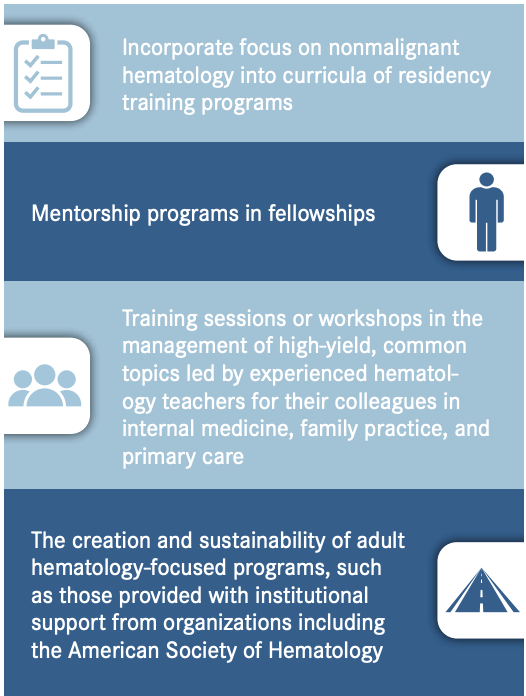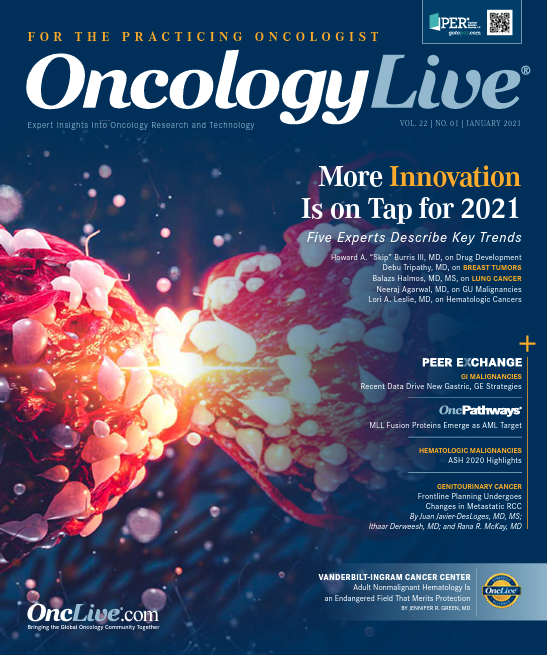Publication
Article
Adult Nonmalignant Hematology Is an Endangered Field That Merits Protection
Author(s):
The scope of adult nonmalignant hematology can be broad and includes thrombotic and hemorrhagic disorders, transfusion medicine, hemoglobin disorders including sickle cell disease and thalassemia, anemia, thrombocytopenia, leukocytosis, leukopenia, and disorders of iron metabolism.
Jennifer R. Green, MD

Hematologists use the terms classical, nonmalignant, and benign hematology to reference the same entity: the study and management of nonmalignant disorders of the blood. It is a discipline unto itself, distinct from its sister field, malignant hematology. The scope of practice can be broad and includes thrombotic and hemorrhagic disorders, transfusion medicine, hemoglobin disorders including sickle cell disease and thalassemia, anemia, thrombocytopenia, leukocytosis, leukopenia, and disorders of iron metabolism.
In many health care systems, classical hematologists function as stewards of cost-intensive, specialty-related medications that are often complex and require content knowledge, experience, and clinical expertise for appropriate management.1,2 Others find roles as systems-based hematologists, defined as a specialty-trained physician, employed by a hospital medical center or a health system, who optimizes individual patient care as well as the overall system of health care delivery for patients with blood disorders.1 Duties of these professionals can include implementing health care initiatives for the management of thrombosis or bleeding, working in conjunction with anticoagulation oversight clinics, and standardizing management of therapeutic phlebotomy.
To characterize the future of the workforce for this diverse field, results of an American Society of Hematology (ASH) survey of practicing hematologists projected that nearly 25% of hematologists specializing in nonmalignant disorders would reach retirement age by 2018.2,3,4 This was expected to have a profound impact on creating a workplace shortage.2-4 The study results cited several influences, including the age of the workforce4 and decreasing rates of graduate selection of nonmalignant hematology as a primary area of focus.2,3 Other influences included salary discrepancies between nonmalignant hematology and malignant hematology/oncology, lack of mentorship, and uncertainty regarding nonmalignant hematology job opportunities in nonacademic settings.5 Physicians practicing in adult nonmalignant hematology disorders are now seeing the results of this decreasing specialist collective in clinical care and research.
Educational programs have historically been tasked with attempts to address the shrinking pool of classical hematologists. Prior research showed that only 20% of hematology/oncology fellowship graduates pursued an academic career with a clinical research focus, and only 8% pursued an academic career as a clinicianeducator.3,6 Of the 20%, less than 6% selected careers in nonmalignant hematology.5,6 A great demand exists for well-trained physicians.2,3 Furthermore, literature suggests that soon a large patient volume with hematologic care needs will be without a sufficient number of specialists.5-9
These challenges may require complex solutions (Figure). One initiative is an expansion of easily accessible nonmalignant hematology training and educational resources for both trainees and practicing hematologists/oncologists. Many colleagues have not experienced the opportunity to train with a dedicated mentor in this specialty, as fellowship programs can vary significantly in their faculty experience with nonmalignant hematology. In fact, many programs have few available dedicated hematologists on staff for teaching and clinical care.2 Guidance and widely disseminated education can enhance practitioner comfort in the management of hematologic conditions when programs do not have an available content area expert.
Figure. Areas of Opportunity to Expand Training in Nonmalignant Hematology Disorders

Additional focus should be given to the enlistment and training from colleagues to surmount this disparity. Offering training sessions or workshops in the management of high-yield, common topics led by experienced hematology teachers for their colleagues in internal medicine, family practice, and primary care could provide a foundation for initial management of hematologic issues, improved comfort with the subject matter, and an enhanced understanding of the indications for specialist referral. Topics of interest include management of iron-deficiency anemia, simple and complex thromboses, anticoagulation oversight, bleeding evaluations, thrombotic microangiopathy presentation and identification, and the initial evaluation of cytopenias. These examples represent common scenarios with significant intersection with classical hematology.
Residency training programs may also find the opportunity to incorporate nonmalignant hematology focus into their curricula. Not only would this serve to improve proficiency and prepare trainees for the reality of their practice, but it would also be a step toward eliminating the gap in care that will be left by a workplace shortage.
A clear and prominent need also exists to train more classical hematologists to increase consultant availability across subspecialties. ASH has undertaken this issue in prior years through the creation of its Recruitment and Retention Working Group, a study collaborative with The George Washington University Fitzhugh Mullan Institute for Health Workforce Equity, and it has raised awareness through publication and educational initiatives.2,3,10 In October 2020, ASH announced that it will provide “institutional funding to develop 10 new innovative hematology-focused fellowship tracks within existing adult hematologyoncology training programs.”10 The training provided in the educational platform must lead to eligibility for American Board of Internal Medicine hematology certification. The goal of the program is to generate enough recruitment and training to add at least 50 academic hematologists in the coming years, with a focus on training hematologists in nonmalignant disorders.10 More information will follow when the request for proposals becomes available on February 15, 2021. Additional information is available at https://bit.ly/37Gmyic.
Well-informed hematologists/oncologists can also play a critical role in reshaping the trajectory of these gaps through raising awareness, participating in professional societies and continuing medical education, teaching students and trainees, and recruiting colleagues to extend these efforts. The nurture and retention of nonmalignant hematology content expertise is a critical aspect of health care that merits protection.
References
- Wallace PJ, Connell NT, Abkowitz JL. The role of hematologists in a changing United States health care system. Blood. 2015;125(16):2467-2470. doi:10.1182/blood-2014-12-615047
- Gormley C. Innovative education, training strategies needed to address shortage of benign hematologists. HemOnc Today. November 22, 2017. Accessed December 8, 2020. https:// www.healio.com/news/hematology-oncology/20171116/ innovative-education-training-strategies-needed-to-address-shortage-of-benign-hematologists
- Marshall AL, Jenkins S, Mikhael J, Gitlin SD. Determinants of hematology-oncology trainees’ postfellowship career pathways with a focus on nonmalignant hematology. Blood Adv. 2018;2(4):361-369. doi:10.1182/bloodadvances.2017013722
- Lawrence L. Adapting to changes in practice-based hematology. ASH Clinical News. May 15, 2015. Accessed December 8, 2020. https://www.ashclinicalnews.org/spotlight/adapting-to-changes-in-practice-based-hematology/
- Sharma D, Wallace N, Levinsohn EA, et al. Trends and factors affecting the US adult hematology workforce: a mixed methods study. Blood Adv. 2019;3(22):3550-3561. doi:10.1182/bloodadvances.2019000307
- Todd RF III, Gitlin SD, Burns LJ; Committee on Training Programs. Subspecialty training in hematology and oncology, 2003: results of a survey of training program directors conducted by the American Society of Hematology. Blood. 2004;103(12):4384-4388. doi:10.1182/blood-2003-11-3986
- Horn L, Koehler E, Gilbert J, Johnson DH, et al. Factors associated with the career choices of hematology and medical oncology fellows trained at academic institutions in the United States. J Clin Oncol. 2011;29(29):3932-3938. doi:10.1200/ JCO.2011.35.8663
- Hill QA, Hill A, Allard S, Murphy MF. Towards better blood transfusion—recruitment and training. Transfus Med. 2009;19(1):2-5. doi:10.1111/j.1365-3148.2008.00901.x
- Sinsky CA, Dugdale DC. Medicare payment for cognitive vs procedural care: minding the gap. JAMA Intern Med. 2013;17(18):1733-1737. doi:10.1001/jamainternmed.2013.9257
- Hematology-focused fellowship training program. American Society of Hematology. Accessed December 8, 2020. https://www.hematology.org/education/educators/ resources-for-training-program-directors/hematology-focused-fellowship-training-program









